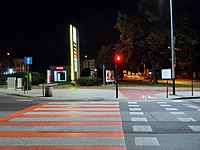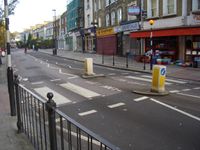Tag:highway=crossing: Difference between revisions
m (+template) |
Minh Nguyen (talk | contribs) (Rewrote the definition for clarity) |
||
| Line 3: | Line 3: | ||
|value=crossing |
|value=crossing |
||
|image=Image:Zebra-crossing sm.jpg |
|image=Image:Zebra-crossing sm.jpg |
||
|description= |
|description=The location of a designated street crossing for pedestrians, cyclists, or equestrians |
||
|onNode=yes |
|onNode=yes |
||
|onWay=no |
|onWay=no |
||
| Line 13: | Line 13: | ||
}} |
}} |
||
This tag is for the location of a designated '''street crossing''' for pedestrians, cyclists, or equestrians. In American English, a crossing is called a ''crosswalk'' if it is marked or signalized. |
|||
This tag is only used on nodes. If a crossing is also represented by a way, use a different {{tag|highway}} value corresponding to the kind of path that crosses the street, for example {{tag|highway|footway}} {{tag|footway|crossing}} for a pedestrian crossing. |
|||
== How to map == |
== How to map == |
||
To map a |
To map a street crossing, place a node {{IconNode}} along the way representing the road, and add the {{Tag|highway|crossing}} tag to the node. |
||
To describe the type of the transition in more detail, use: |
To describe the type of the transition in more detail, use: |
||
Revision as of 18:08, 2 March 2022
| Description |
|---|
| The location of a designated street crossing for pedestrians, cyclists, or equestrians |
| Group: crossings |
| Used on these elements |
| Useful combination |
|
| Status: de facto |
| Tools for this tag |
|
This tag is for the location of a designated street crossing for pedestrians, cyclists, or equestrians. In American English, a crossing is called a crosswalk if it is marked or signalized.
This tag is only used on nodes. If a crossing is also represented by a way, use a different highway=* value corresponding to the kind of path that crosses the street, for example highway=footway footway=crossing for a pedestrian crossing.
How to map
To map a street crossing, place a node ![]() along the way representing the road, and add the highway=crossing tag to the node.
along the way representing the road, and add the highway=crossing tag to the node.
To describe the type of the transition in more detail, use:
- crossing=*
- crossing=traffic_signals - regulated with light signals
- crossing=uncontrolled (used by JOSM preset) - with crosswalk without traffic lights
- crossing=marked (used by iD preset) - with crosswalk without traffic lights
- crossing:island=yes/no - to tag whether there is an island (former tag
crossing=island) - crossing=unmarked - without markings or traffic lights
- bicycle=yes/no - to tag whether the crossing is also a cycleway crossing used by bicycles. Notice that a crossing tagged with bicycle=no may be crossing a road where cycling is allowed[1]
- horse=yes/no - to tag whether the crossing is also a bridleway crossing used by horse riders.
See the Key:crossing page for additional documentation of this and many other available subtags.
Separately mapped footways
- Main article: Sidewalks#Sidewalk_as_separate_way
In case of sidewalks mapped as separate ways it is necessary to add also crossing way, from one sidewalk through node shared with a road to the another sidewalk footway=crossing and cycleway=crossing can be used on ways which lead from a sidewalk to the crossing node (the node which has this highway=crossing tag).
Such split can be also done when footway/cycleway is crossing the road (part where it is crossing may tagged with footway=crossing / cycleway=crossing).
Examples
| Example | Tagging |
|---|---|

|
|

|
Adding bicycle=no would be basically pointless, as on other crossings not attached to cycleways or footways where cycling is allowed |

|
|

|
|

|
Rendering
- Shows up in OSM2World and in OSM France.
- OpenCycleMap:
 ,
,  bicycle=yes
bicycle=yes - It also is displayed in the JOSM Editor
Routing
Used by OsmAnd, a routing software, to signal and alert.
See also
- railway=crossing - Pedestrians can cross a railway here
- railway=level_crossing - A crossing between a railway and a road
- railway=tram_crossing - A tram crosses the pedestrian way here
- railway=tram_level_crossing - A tram crosses the road here
- railway=railway_crossing - Crossing rails that do not interconnect
- railway=switch - A railway switch
- crossing=* - Further refinement for nodes already tagged with highway=crossing or railway=crossing
References
- ↑ See documentation of bicycle=dismount, see discussions such as for example https://lists.openstreetmap.org/pipermail/tagging/2020-October/thread.html#55611 https://lists.openstreetmap.org/pipermail/tagging/2020-October/thread.html#55632
- ↑ strictly speaking it is legal during night (when max speed on road is raised to 60 km/h and during very bad weather)
